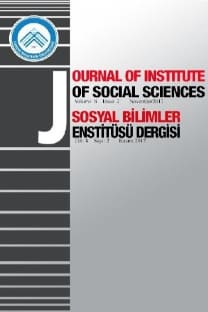Sosyal Medyanın Uyuşturan Etkisi
Narcotizing Effect of Social Media
___
- Balkin, J. M. (2004) 'Digital Speech and Democratic Culture: A Theory Of Freedom of Expression for the Information Society', NYU Law Review, 79(1): 1–55.
- Barlow, J. P. (1996). An Declaration of Independence of Cyberspace, Retrieved (Accessed on 11 February 2016).
- http://editions-hache.com/essais/pdf/barlow1.pdf
- Barnett, S. (2010) What’s wrong with media monopolies? A lesson from history and a new approach to media ownership policy. ‘MEDIA@LSE Electronic Papers’http://www.lse.ac.uk/media@lse/research/mediaWorkingPapers /pdf/EWP18.pdf(Accessed on February 5, 2016) Working
- Bell, C. V. (2013) “Clicktivism.” In Kerric Harvey (ed.), The Encyclopedia of Social Media and Politics (pp. 283-284). Thousand Oaks, CA: CQ Press/SAGE
- Berger, G., (2002). Theorizing the Media – Democracy Relationship in Southern Africa. The International Journal for Communication Gazette, Vol. 64, No.1, London: Sage Publications.
- Boyd, D. (2007). Why Youth (Heart) Social Network Sites: The Role of Networked Publics in Teenage Social Life. David Buckingham (Ed). MacArthur Foundation Series on Digital Learning – Youth, Identity, and Digital Media Volume (119-142). Cambridge: MIT Press.
- Breindl, Y. (2010) Critique of the Democratic Potentialities of the Internet: A Review of Current Theory and Practice. TripleC. Vol. 8(1): 43 – 59
- Eltantawy, N. & Wiest, J. B. (2011) ‘Social Media in the Egyptian Revolution: International Journal of Communication, Vol. 5: 1207 – 1224. Resource Mobilization Theory’.
- Eşitti, Ş. (2015). Bilgi Çağında Problemli İnternet Kullanımı ve Enformasyon Obezitesi: Problemli İnternet Kullanımı Ölçeğinin Üniversite Öğrencilerine Uygulanması. İstanbul Üniversitesi İletişim Fakültesi Dergisi, 49(2), 75-97., DOI: 10.17064/iüifhd.90504
- Fuchs, C. (2011). New Media, Web 2.0. and Surveillance. Sociology Compass. Vol. 5 No. 2: 134 – 147
- Gezgin, S. (2006). Medya ve Demokrasi. 20. Alman-Türk Gazeteciler Semineri. http://www.konrad.org.tr/Medya%20Mercek/19gezgin.pdf on 19 February 2016) pp. 165 – 176. (Accessed
- Gladwell, M. (2011). From innovation to revolution-do social media made protests possible: An absence of evidence. Foreign Affairs, https://www.foreignaffairs.com/articles/2011-01-19/innovation- revolution(Accessed on 19 February 2016)
- Hassanpour, N. (2011). Media disruption exacerbates revolutionary unrest: Evidence from Mubarak’s natural experiment, APSA 2011 Annual Meeting Paper.
- Hess, D. J., Breyman, S., Campbell, N., Martin, B., (2008), Science, Technology, and Social Movements, In Hackett, E.J., Amsterdamska, O., Lynch, M., Wajcman, J. (eds.), The Handbook of Science and Technology Studies, (pp. 473-498), 3rd edition, Cambridge: MIT Press.
- Howard, P. N., and Hussain, M. M. (2011) The Role of Digital Media, Journal of Democracy, Vol. 22, no. 3, pp. 36-48
- Karpf, D. (2010). Online political mobilization from the advocacy group's perspective: Looking beyond clicktivism. Policy & Internet, 2(4), 7-41
- Katz, E., Gurevitch, M., & Haas, H. (1973). On the Use of the Mass Media for Important Things. American Sociological Review, 38 (2), pp. 164- 181.
- Kerrigan, S. (2011). “US Gov. Software Creates ‘Fake People’ on Social Networks.” http://www.examiner.com/article/us-gov-software-creates-fake-people- on-social-networks.(Accessed on 19 February 2016) at
- Kietzmann, J. H., Hermkens, K., McCarthy I. P. and Silvestre, B. S. (2011). Social media? Get serious Understanding the Functional Building Blocks of Social Media. Business Horizons, Vol. 54, 241- 251.
- Kırık, A. M. (2015). Sivil Toplumun Sınırlandırılamayan Sosyal Medya Sorunsalı. Ahmet Çetinkaya, Ali Murat Kırık, Özgür Erkut Şahin (Eds). Bilişim ve... (161-184). İstanbul: Hiperlink Yayınları.
- Kwak, H., Lee, C., Park, H., & Moon, S. (2010, April). What is Twitter, a social network or a news media? In Proceedings of the 19th international conference on World Wide Web (pp. 591–600). Retrieved from http://dl.acm.org/citation.cfm?id=1772751. (Accessed on 19 February 2016)
- Lazarsfeld P. F., Merton R. K. (1948). Mass Communication, Popular Taste and Organized Social Action. In. Mass Culture: The Popular Arts in America. B. Rosenberg and D.M. White (Eds.) (1957). New York: The Free Press
- Lyon, D (2007). Surveillance Studies: An Overview. Cambridge: Polity
- Morozov, E. (2009, May 19). “The brave new world of slacktivism,” Foreign http://www.npr.org/templates/story/story.php?storyId=104302141(Acce ssed on 19 February 2016) Policy. Retrieved from:
- Morozov, E. (2011). The Net Delusion The Dark Side Of Internet Freedom. New York: Public Affairs.
- Panday, P. K. (2009). Does globalization affect media role in a democratic country? Communication Studies, 1 (2), 33–42.
- perspective. Journal of Media and
- Safko, L. (2010). The Social Media Bible: Tactics, Tools, and Strategies for Business Success. New Jersey: John Wiley & Sons, Inc.
- Smith, C. (2011) "Egypt's Facebook Revolution: WaelGhonim Thanks the Social http://www.huffingtonpost.com/2011/02/11/egypt-facebook-revolution- wael-ghonim_n_822078.html (Accessed on February 15, 2016) Post,
- Trottier, D. (2012) Social Media as Surveillance. Surrey. Ashgate Publising
- Unwin, T. (2012) Social media and democracy: critical reflections. Background Paper for Commonwealth Parliamentary Conference, Colombo, http://www.cpahq.org/cpahq/cpadocs/Unwin%20CPA%20Social%20m edia%20and%20democracy.pdf (Accessed on Februay 29, 2016) From:
- Vanobberghen, W. (2007), ‘The marvel of our time’: visions surrounding the introduction of radio broadcasting in Belgium 1923-1928, Paper presented at Media history and history in the media: Media and time, Wales, Gregynog (University of Aberyswyth), 28 - 30 March 2007.
- Wilson, E. J. (2009). Digital Democracy and Diversity. Amit Schejter (Ed.) … And Communications for All: A Policy Agenda For a New Administration. (29 – 39). Lanham, MD: Lexington Books.
- ISSN: 1309-3738
- Yayın Aralığı: 2
- Başlangıç: 2010
- Yayıncı: Prof. Dr. Coşkun POLAT
Oğuz Atay’ın “Unutulan” ve “Korkuyu Beklerken” Adlı Hikâyelerinde Gotik Unsurlar
Üniversite Öğrencilerinin Barınma Yeri Tercihleri: Havza Meslek Yüksekokulu Örneği
Türkiye’nin Büyükşehir Belediyesi Sistemi:1982-2015
Hüseyin ÖZGÜR, Pınar SAVAŞ YAVUZÇEHRE
Küçük Frank Yıllıkları I: Aziz Amand Yıllığı
Kurumsal Karnenin Bir Stratejik Yönetim Aracı Olarak İncelenmesi
Cenk Laçin ARIKAN, Didem ENGİNOĞLU
İslam Hukuku Açısından Mahremiyet-Zaman İlişkisine Mukayeseli Bir Bakış
1980 Sonrası Türk Şiirinde Divan Şiiri Nazım Şekillerinin Kullanımına Dair
Kurumsal Yönetim Uygulamalarının Denetim Kalitesine Etkisi Üzerine Bir Araştırma
